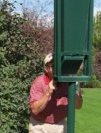The USGA Green Section
Record |
|
|
|
|
April 22, 2011 -- Volume 49, Number 16
|
|
| Golf Courses Benefit People And The Environment | What are the principles?
by the USGA Green Section Staff |  Although many Americans enjoy working in their yards and maintaining an attractive landscape, they may not realize the tangible benefits of their efforts. These same benefits are available on the golf course where the combination of mowed turf, trees and natural areas provides a diverse environment for people and wildlife. Preserving these green spaces improves the environmental quality of the entire community. Although many Americans enjoy working in their yards and maintaining an attractive landscape, they may not realize the tangible benefits of their efforts. These same benefits are available on the golf course where the combination of mowed turf, trees and natural areas provides a diverse environment for people and wildlife. Preserving these green spaces improves the environmental quality of the entire community.
As the game of golf has become more popular, people have become interested in how golf affects land resources and the environment. Many organizations in golf are actively answering these questions. In the past several years, the United States Golf Association (USGA) has supported more than 90 university studies and research projects to evaluate the relationship between golf and the environment.
The golf course ecosystem:
- Provides wildlife habitat
- Protects topsoil from water and wind erosion
- Improves community aesthetics
- Absorbs and filters rain
- Improves health and reduces stress for more than 24.5 million golfers
- Improves air quality
- Captures and cleanses runoff in urban areas
- Discourages pests (e.g. ticks and mosquitoes)
- Restores damaged land areas (e.g. former landfill or mining sites)
- Makes substantial contributions to the community's economy
This document highlights the benefits of turf, trees and natural areas as commonly found on golf courses. The information presented about these benefits is supported by factual, unbiased university research. Further information about any specific benefit - and the research from which it was drawn - can be provided by the USGA.
Read the rest of this document, which includes a brief explanation of each benefit. |
| The Park Grass Experiment And The Fight Against Dogma | Sometimes the value of a turfgrass management program takes a long time to become apparent
by Micah Woods and Frank Rossi |
 | |
A view over the unmown plots showing a sharp distinction in plant species based on fertilizer applications.
|
It seems we are inundated with new technology for golf turf management. Technology can be a vital aspect of turf management, yet it can also be distracting. When technology distracts us from the basic biological and ecological principles, we lose the value of resource efficiency.
Current research can inform our decisions about technology, but often it is short term and gives rise to dogma, i.e., stating an opinion as if it were fact. However, understanding fundamental principles often requires a longer period of study and, when properly assessed with variable technology, can lead to informed decision-making.
Few would argue the value of long term ecological research, especially when it can continue to be relevant to modern management. We would argue that the most important experiment of this type has been underway outside of London since 1856 at the Rothamsted Experiment Station.
Dr. Micah Woods (micah@asianturfgrass.com) is research director at the Asian Turfgrass Center. Dr. Frank Rossi (fsr3@cornell.edu) is an associate professor in the Horticulture Department at Cornell University.
Read the rest of this article
|
| On Course With Nature - Greening The Game | The business value of environmental stewardship
by Kevin Fletcher and Joshua Conway
|
 | |
North Shore Country Club (Glenview, Illinois) has been a Certified Audubon Cooperative Sanctuary since 1998.
|
No matter where you turn, new economic realities are re-shaping the ways businesses operate. Yet, even as we manage our way through this significant economic downturn, a broader interest in protecting the natural environment has remained a lead news item. As a result, businesses today are thinking differently about the environment and are making environmental stewardship a part of their core business strategy. This is also the case for golf course operations, and many are doing so through the Audubon Cooperative Sanctuary Program for Golf Courses(ACSP).
The ACSP, started by Audubon International 20 years ago with support from the United States Golf Association, is based on the simple concept that effective planning leads to positive actions and ultimately is good business. Often, these opportunities for marrying good environmental action with business value are relatively simple and build on the strengths of a golf facility. For instance, golf courses working through the ACSP have been able to convert an average of 22 acres of land from heavily managed turfgrass to less managed natural areas for wildlife. This, in turn, has led to reduced water, chemical, fuel, and labor resources, without compromising quality of play. That is money saved.
Kevin A. Fletcher, Ph.D., is Executive Director and Joshua Conway is Education and Communications Manager of Audubon International.
Read the rest of this article
|
| Regional Updates | |
 Tried and True Tried and True
by Bob Vavrek, senior agronomist, North-Central Region
There's not much to like about the extended period of exceptionally cool, wet weather this spring unless you are the fungus that causes Microdochium patch (pink snow mold). No doubt, the thunder that accompanied heavy rain and sleet in Milwaukee must be music to the ears of this and other pathogens that cause a variety of cool temperature turf diseases.
 | |
Pink snow mold and Microdochium patch are caused by the same pathogen at different times of the season. Pink snow mold is relatively easy to diagnose just after the snow melts, but Microdochium patch can occur anytime later in the season when conditions are favorable for disease activity and often can be mistaken for dollar spot. |
Spring green-up at golf courses across the Region is nearly a month behind the early start to the season last year. No doubt, it is difficult to think about firing up the sprayer when only a handful of rounds have been played and a considerable amount of turf on the course is still semi-dormant.
The fact that it may be approaching six months since the greens have been treated with any fungicide should provide turf managers ample encouragement to replace nozzles, calibrate the sprayer, and begin a thorough scouting program for disease activity. Keep in mind that turf treated with fungicides, particularly contact materials, just prior to snowfall last year may have already been exposed to sunlight for six to eight weeks by now, so there is no reason to expect any residual protection. | |
Read the rest of this update
 Sand is Good for the Game Sand is Good for the Game
by Todd Lowe, agronomist, Florida Region  Sand topdressing is not a new practice, having been used by Old Tom Morris at St. Andrews. Yet, it seems that we continue to talk about this misunderstood practice to golfers each year. Some golfers believe that it disrupts playing conditions, when in fact it improves playability. Educating golfers is a continual, yet worthwhile, endeavor to decrease frustration for all parties. Sand topdressing is not a new practice, having been used by Old Tom Morris at St. Andrews. Yet, it seems that we continue to talk about this misunderstood practice to golfers each year. Some golfers believe that it disrupts playing conditions, when in fact it improves playability. Educating golfers is a continual, yet worthwhile, endeavor to decrease frustration for all parties.
Read the rest of this update.  What Happened to Our Golf Course? What Happened to Our Golf Course?
by Derf Soller, agronomist, Northwest Region A recent quick one-thousand-mile trip across Colorado, and numerous phone conversations with superintendents in adjoining states, has led to some common threads and comments. One commonality is that it's still not really spring, no matter what the calendar says. Winter snow mold activity has been showing its ugly head. Many golf courses experienced some level of disease activity this winter, but I guess you could say it's part of the price of doing business. Golfers and course management staff always want to know what happened, but unfortunately, it is just not that easy to say. Most often it is not just one thing that can cause increases in winter damage, but more likely a combination of many factors. Read the rest of this update.  Kill the Rye Or the Bermuda Will Die Kill the Rye Or the Bermuda Will Die
by Brian Whitlark, agronomist, Southwest Region It is well documented that overseeding with perennial ryegrass year after year will reduce bermudagrass growth and recovery in the spring (http://turf.lib.msu.edu/2000s/2005/050322.pdf). In the last ten years, turf managers in the Southwest Region have changed their practices to proactively manage the transition from overseeded ryegrass to bermudagrass, often by a combination of mechanical and chemical means. The question I often hear as summer approaches is when should such practices begin? It is important to recognize that bermudagrass green-up and active growth begin under different conditions. Green-up typically begins when soil temperatures at the four-inch depth reach 55 degrees F. However, active growth of the bermudagrass is said to occur under the following conditions: - When soil temperatures at the four-inch depth reach 65 degrees F.
- When the minimum air temperature exceeds 65 degrees for seven consecutive nights.
Read the rest of this update.
|
| Green Section Record Archive (digital) | Looking for a previous issue of the Green Section Record?
|
 | |
Looking for something? |
The Green Section Record has been published under various names since 1921 and is composed of an amazing collection of full-text articles and photos. This collection is stored and maintained by the wonderful library staff at Michigan State University in the Turfgrass Information File (TGIF). All past issues of the Record, right up to and including this one, can be accessed free-of-charge by following this link. Search the Green Section Record |
| The USGA Green Section Portal |
A Valuable, Free Resource |
Take a minute to visit the Green Section's portal at http://gsportal.usga.org to find information regarding upcoming live webcasts and links to recordings of more than 30 previously-delivered webcasts and announcements of upcoming USGA Green Section activities, education conferences, and meetings. |
|
|
|
| USGA Green Section
P.O. Box 708
Far Hills, NJ 07931-0708 908.234.2300
| |

©2011 by United States Golf Association®
Permission to reproduce articles or material in the USGA Green Section Record is granted to
newspapers, periodicals, and educational institutions unless specifically noted otherwise. All materials
must be used in their entirety. Credit must be given to the author, the article's title, the USGA Green
Section Record, and the issue's date. Copyright protection must be afforded. No material may be
copied or used for any advertising, promotion or commercial purposes.
Green Section Record (ISSN 2156-5813) is published weekly via electronic mail by the
United States Golf Association®, Golf House, Far Hills, NJ 07931. |
|
|
|
|
|